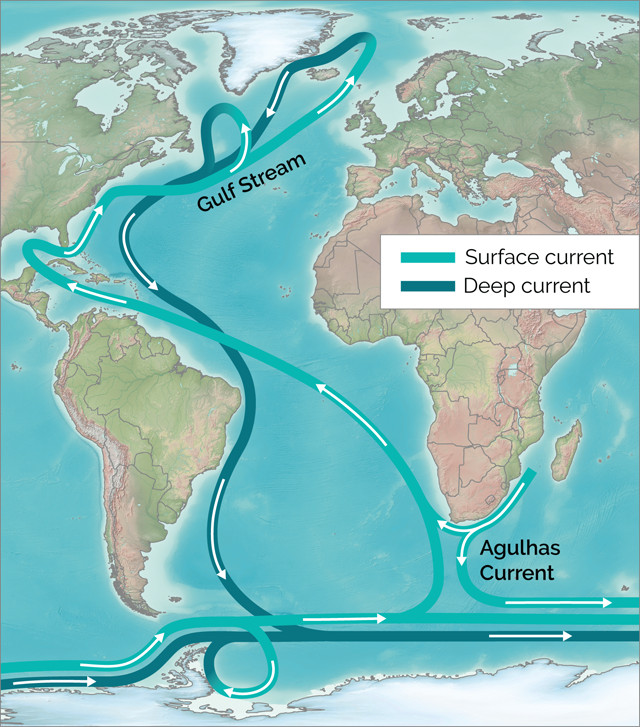
by Adityarup "Rup" Chakravorty Monday, September 10, 2018
In the 1920s, Serbian scientist Milutin Milankovitch proposed that cyclical changes in Earth’s orbital eccentricity, as well as its axial tilt and orientation, shape global climate. Part of his theory — widely accepted since — is that the amount of solar radiation, or insolation, reaching high northern latitudes is a major factor in regulating global ice volume and albedo, which in turn control the strength of tropical monsoons. But in a new study, researchers suggest that instead of global ice volume regulating monsoon strength, it’s mostly the other way around.
“We are not saying that the Milankovitch theory is wrong, but rather that it is incomplete,” says J. Warren Beck of the University of Arizona, lead author of the new study in Science. “While some changes in global ice volume are undoubtedly linked to high northern latitude summer insolation directly,” Beck says, “we assert that a significant fraction, possibly the lion’s share, of the changes may arise via monsoon control of energy and moisture export pathways [from the tropics] to high latitudes.”
Central to Beck’s team’s argument are results from their work studying beryllium-10, a proxy for rainfall intensity, in soils in part of central China over the last 550,000 years. For millions of years, wind has blown dust from Central Asia into this region and created layers of thick deposits called loess. Beryllium-10 is created when cosmic rays collide with nitrogen or oxygen atoms in the atmosphere; the newly created beryllium atoms are deposited with rainfall, so the soil in central China carries a record of past rainfall. By analyzing sediments from different depths, researchers can get an idea of weather and rainfall patterns at specific times in the past.
As estimated by beryllium-10 flux, rainfall in the study area — 160 kilometers west of the city of Xi’an — over roughly the past half million years correlated strongly with sea level, itself a proxy for global ice volume, but correlated only modestly with solar insolation in the far north.

One way the Indian summer monsoons may affect global ice cover is through the Agulhas Current, which flows southwest along the eastern coast of Africa. Some water spills around the southern tip of Africa, where it joins up with the Gulf Stream in the Atlantic, carrying warmer waters to the North Atlantic and Arctic. Credit: K. Cantner, AGI.
“That’s a conundrum,” Beck says, because according to the Milankovitch theory, the amount of solar insolation in the high northern latitudes should directly correlate with monsoon strength via global ice volume.
Adding to the mystery is that past rainfall estimated using a different, commonly used proxy — levels of oxygen-18 in Chinese cave stalagmites — does appear to tightly correlate with solar insolation at high latitudes, as expected in the Milankovitch model. But this proxy only loosely correlates with global sea-level changes.
“Clearly, the beryllium-10 record and the cave oxygen-18 records are not recording the same thing,” Beck says.
The researchers propose that the Chinese cave oxygen-18 records track where past rainfall originated, not its intensity. This theory has been proposed by others as well, including Barbara Maher, a paleomagnetism researcher at the University of Lancaster in England, and colleagues, who measured magnetic properties of Chinese loess sediments as a proxy of past rainfall.
“Two of the proxies — beryllium-10 flux and magnetic properties — match each other, but they are not tightly correlated with the oxygen-18 record,” Maher says. “This study agrees with my previous conclusion that the oxygen-18 record is telling us whether the monsoon systems that brought the rains came from near or far.”
Rains come to central China from two arms of the Asian monsoon system: The East Asian summer monsoon travels a short distance from the Pacific, whereas the Indian summer monsoon travels much farther from the Indian Ocean, crossing the Indian subcontinent and the Tibetan Plateau before reaching central China. As it travels farther, the Indian Ocean moisture becomes more depleted in oxygen-18 than Pacific moisture. Thus, in years when more rain came from the Indian Ocean, the cave records would show relatively low levels of oxygen-18.
To further explore the correlation between monsoonal rainfall, as measured with the beryllium-10 proxy, and global ice volumes, Beck and colleagues modeled how stronger Indian summer monsoons could ultimately reduce global ice cover. One proposed pathway is via the Agulhas Current, which flows southwest along the eastern coast of Africa. Some amount of the water carried by the current spills into the South Atlantic Ocean, where it ultimately joins up with the Gulf Stream and helps bring warm water to the North Atlantic and Arctic oceans, increasing temperatures and reducing ice cover. When the Indian monsoon is weaker, the Agulhas Current doesn’t affect the Atlantic cycle as much, and less warm water makes it into the high northern latitudes.
“Once you accept that the various loess or cave records may be telling you more about climate events in low-latitude areas, you start to see that these records may be caused by changes in the low-latitude areas,” Maher says.
© 2008-2021. All rights reserved. Any copying, redistribution or retransmission of any of the contents of this service without the expressed written permission of the American Geosciences Institute is expressly prohibited. Click here for all copyright requests.